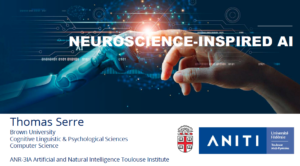Objectives of the chair
La vision artificielle a souvent été décrite comme l’une des clés à résoudre avant que les machines puissent agir intelligemment. De récentes avancées dans un domaine du Machine Learning, connu sous le nom Deep Learning, a catalysé des progrès impressionnants en vision artificielle, donnant le sentiment que les problèmes connus dans le domaine de la vision sont sur le point d’être résolus. Malgré ces réussites, il devient également de plus en plus évident que les réseaux de neurones profonds actuels restent dépassés par la puissance et la polyvalence
of the primate brain.
Ainsi, notre recherche vise à capitaliser sur la recherche en neurosciences pour informer sur le développement d’une nouvelle génération d’algorithmes d’IA inspirés du cerveau.
Program Acceptable, certifiable & collaborative AI
Thèmes : apprentissages avec peu de données ou des données complexes, langage, Neuroscience et IA, Robotique et IA
Chair holder:
Thomas Serre, Brown University and ANR-3IA ANITI
Sites
https://vivo.brown.edu/display/tserre
Publications
https://serre-lab.clps.brown.edu/publications/
Chair holder: Thomas Serre (Brown University)
PhD students
- Aimen Zerroug, 2019-2022;
- Mathieu Chalvidal, 2020-2023;
- Mohit Vaishnav, 2019-2022;
- Thomas Fel, 2021-2024
Post-docs
- Victor Boutin, 2020-2022;
- Amor Ben-Tanfous, 2020-2021
- A. Alamia, C. Luo, M. Ricci, J. Kim, T. Serre & R. VanRullen. Differential involvement of EEG oscillatory components in sameness vs. spatial-relation visual reasoning tasks. eNeuro, 2020 (accepted)
- V. Boutin, A. Zerroug, M. Jung, & T. Serre. Iterative VAE as a predictive brain model for out-of-distribution generalization. NeurIPS workshop on Shared Visual Representations in Human and Machine Intelligence (SVRHM), 2020
- M. Chalvidal, M. Ricci, R. VanRullen, T. Serre. Go with the flow: Adaptive control for Neural ODEs. International Conference on Learning Representations (ICLR), 2021
- J.K Kim, M. Ricci & T. Serre. Learning same-different relations strains feedforward neural networks. Interface Focus (special issue on ‘Understanding images in biological and computer vision’), 8(4), 2018
- J.K. Kim, D. Linsley, K. Thakkar & T. Serre. Disentangling neural mechanisms for perceptual grouping. In Proc. International Conference on Learning Representations, 2020
- G. Kreiman & T. Serre. Beyond the feedforward sweep: feedback computations in the visual cortex. The Year in Cognitive Neuroscience, 2020
- G. Lindsay & T. Serre. Deep learning networks and visual perception. Oxford Research Encyclopedia of Psychology, 2020 (to appear)
- D. Linsley, J. Kim, V. Veerabadran, C. Windolf & T. Serre. Learning long-range spatial dependencies with horizontal gated-recurrent units. Proc. Neural Information Processing Systems, 2018a
- D. Linsley, J.K Kim & T. Serre. Recurrent neural circuits for contours detection. In Proc. International Conference on Learning Representations, 2020a
- D. Linsley, A.K. Ashok, L.N. Govindarajan†, R. Liu & T. Serre. Stable and expressive recurrent vision models. In Proc. Neural Information Processing Systems, 2020b
- D. Linsley*, G. Malik*, J.K. Kim, L.N. Govindarajan, E. Mingolla, T. Serre. Tracking without re-recognition in humans and machines. arXiv. 2021
- D.A. Mely, D. Linsley & T. Serre. Opponent surrounds explain the diversity of contextual phenomena across visual modalities. Psychological Review, 125(5), 769-784, 2018
- M. Ricci & T. Serre. Hierarchical models of the visual system. Encyclopedia of Computational Neuroscience,2020.
- M. Ricci, R. Cadene & T. Serre. Same-different conceptualization: A machine vision perspective. Current Opinion in Behavioral Sciences, 2020
- M. Ricci, M. Jung, Y. Zhang, M. Chalvidal, A. Soni & T. Serre. KuraNet: systems of coupled oscillators that learn to synchronize. arXiv. 2021
- T. Serre. Deep learning: The good, the bad, and the ugly. Annual Review of Vision Science, Vol. 5:399-426, 2019
